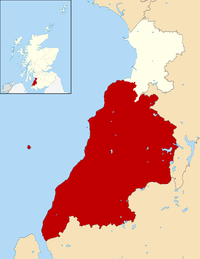Loch Doon
| Loch Doon | |
|---|---|
 | |
| Location | Carrick |
| Coordinates | 55°15′00″N 4°22′19″W / 55.250°N 4.372°WCoordinates: 55°15′00″N 4°22′19″W / 55.250°N 4.372°W |
| Type | freshwater loch |
| Primary outflows | River Doon |
| Basin countries | Scotland |
Loch Doon (Scottish Gaelic: Loch Dhùin, pronounced [ɫ̪ɔxˈɣuːɲ]) is a freshwater loch in Carrick, Scotland. The River Doon issues from its northern end, while the loch itself receives waters from Loch Enoch (in the Galloway Hills) via Eglin Lane.
In the 13th century, it was a site of Balloch Castle, owned by the Earls of Carrick. During the Scottish Wars of Independence it was held by one Gille Brighde, Sir Gilbert de Carrick, a native Carrick nobleman who surrendered it to the English. It was soon recovered by the Scots. In the 15th century, it was frequently in the hands of the Kennedy Clan, although it was briefly in the hands of the Maclellans (backed by William Douglas, 8th Earl of Douglas) after a siege in 1446. The castle was destroyed in the 16th century by King James V as part of a general policy of reducing the power of the barons.
The loch was dammed in the 1930s, raising the water some 27 feet, in order to provide seasonal storage for the Galloway hydro-electric power scheme. As a reservoir, Loch Doon has an effective capacity of over 82 million cubic metres. When rainfall is plentiful, water is diverted to the loch from the Water of Deugh via a tunnel system. When water is required for power generation, water is released at Drumjohn to feed Kendoon power reservoir, the first in a series of generating stations and reservoirs on the Water of Ken.
During the construction of the scheme, the ruins of the castle were moved from an island in the Loch to the shore to avoid the rising water.
See also
External links
| Wikimedia Commons has media related to Loch Doon. |
